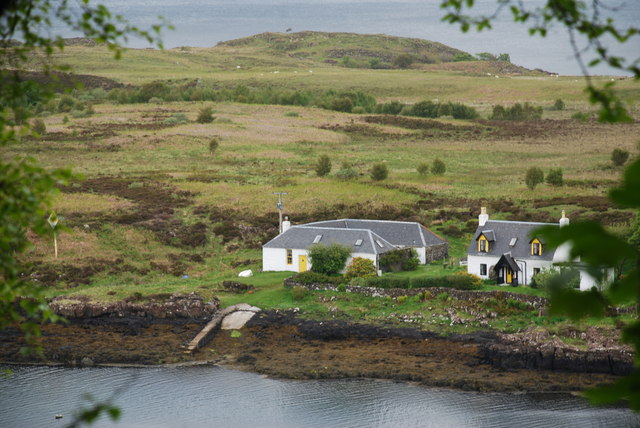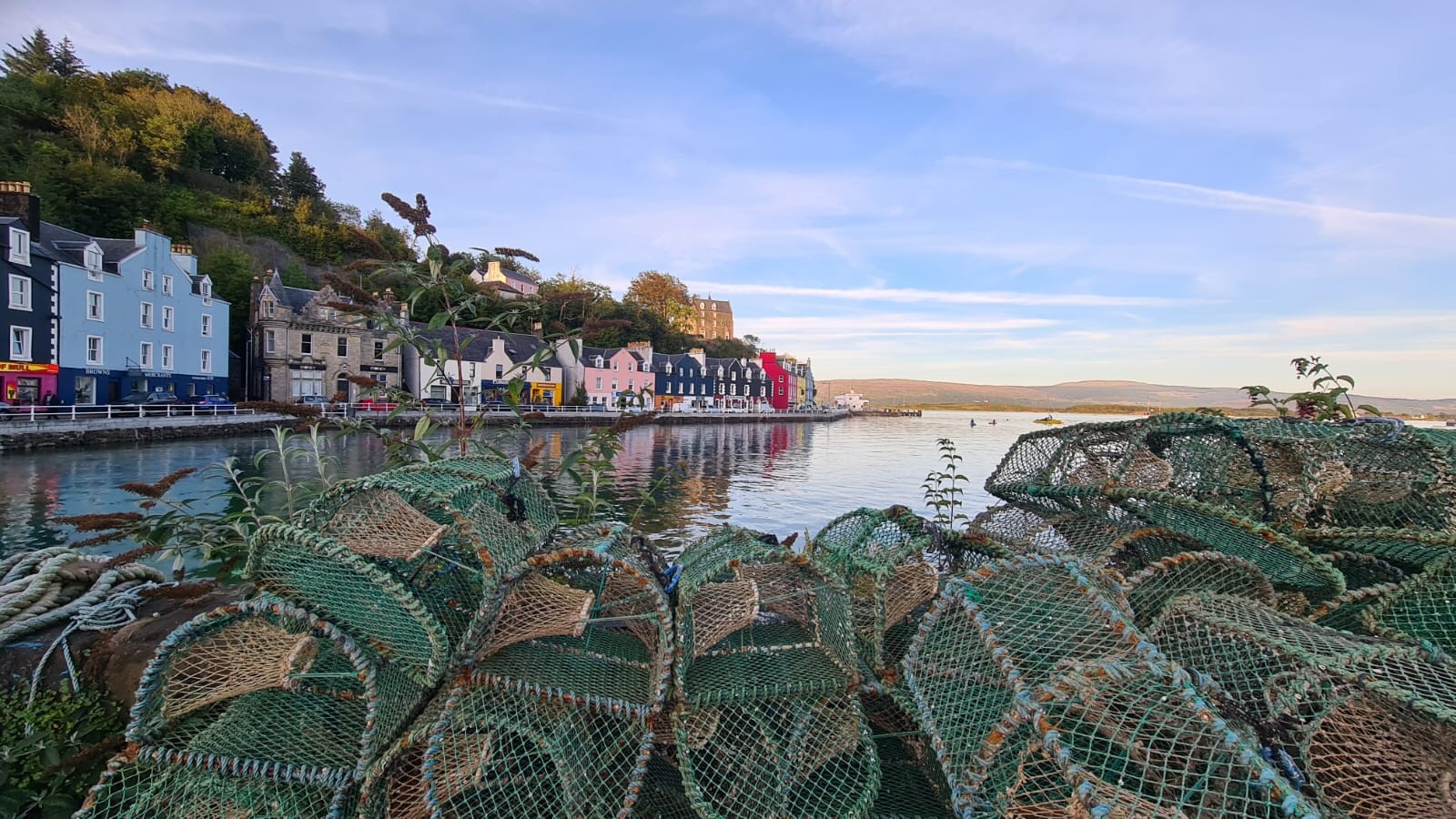|
Calve Island
Calve Island is an uninhabited low-lying island off the east coast of the Isle of Mull in Argyll and Bute on the west coast of Scotland. A whitewashed farmhouse with substantial outbuildings stands on the western shore, used as a summer residence. The island is in length, and wide at its widest point. Calve is owned by the Cotton family who make use of it in the summer months. Tidal offshore islands Calve is classed as a separate island from Mull, although at its south-western point there are extreme low tides that would allow land access to it, via the small tidal island of Cnap a' Chailbhe. Between Mull and Calve runs the channel known as Dòirlinn a' Chailbhe. Calve provides some shelter for Tobermory Bay, helping to make it a safer anchorage. At the north-west of Calve is another small tidal island called Eilean na Beithe. Diving The waters around Calve provide various popular diving sites, both on the rocky walls and reefs and at the wreck of the Pelican. The sheer wal ... [...More Info...] [...Related Items...] OR: [Wikipedia] [Google] [Baidu] |
Tobermory, Mull
Tobermory (; gd, Tobar Mhoire) is the capital of, and until 1973 the only burgh on, the Isle of Mull in the Scottish Inner Hebrides. It is located on the east coast of Mishnish, the most northerly part of the island, near the northern entrance of the Sound of Mull. The village was founded as a fishing port in 1788; its layout was based on the designs of Dumfriesshire engineer Thomas Telford. It has a current population of about 1,000. Etymology The name ''Tobermory'' is derived from the Gaelic ', meaning "Mary's well". The name refers to a well located nearby which was dedicated in ancient times to the Virgin Mary. Prehistory and archaeology Archaeological Excavations have taken place at Baliscate just outside of the town. The site was first noted by Hylda Marsh and Beverley Langhorn as part of the Scotland's Rural Past. In 2009, it was partially excavated Time Team and a further longer excavation took place in 2012 as part of a community archaeology project through the Mul ... [...More Info...] [...Related Items...] OR: [Wikipedia] [Google] [Baidu] |
Alastair Dunnett
Sir Alastair MacTavish Dunnett (26 December 1908 – 2 September 1998) was a Scottish journalist and newspaper editor. He edited '' The Daily Record'' newspaper for nine years and ''The Scotsman'' newspaper from 1956 to 1972. In 1975 he became chairman of Thomson Scottish Petroleum and was much involved in the establishment of the oil terminal at Flotta in Orkney. From the 1950s to the 1980s he was involved in many Scottish cultural activities including being governor of the Pitlochry Festival Theatre (1958–1984). He was awarded an honorary degree of LLD by the University of Strathclyde in 1978 and was knighted on 4 July 1995. He published a book of short stories (''Heard tell'', 1947), a description of a kayaking voyage round the coast of Scotland (''Quest by canoe'', 1950, republished in 1969 as ''It's too late in the year'' and in 1996 as ''The canoe boys''), several books on Scottish topics and an autobiography (''Among friends'', 1984). Dunnett married Dorothy H ... [...More Info...] [...Related Items...] OR: [Wikipedia] [Google] [Baidu] |
Tidal Islands Of Scotland
{{disambiguation ...
Tidal is the adjectival form of tide. Tidal may also refer to: * ''Tidal'' (album), a 1996 album by Fiona Apple * Tidal (king), a king involved in the Battle of the Vale of Siddim * TidalCycles, a live coding environment for music * Tidal (service), a music streaming service * Tidal, Manitoba, Canada ** Tidal station, Tidal, Manitoba See also * Tidal flow (traffic), the flow of traffic thought of as an analogy with the flow of tides * Tidal force, a secondary effect of the force of gravity and is responsible for the tides * Tide (other) A tide is the rise and fall of a sea level caused by the Moon's gravity and other factors. Tide may also refer to: Media * The Tide (Nigeria), ''The Tide'' (Nigeria), a newspaper *Tide (TV series), ''Tide'' (TV series), 2019 Irish/Welsh/Scottish ... [...More Info...] [...Related Items...] OR: [Wikipedia] [Google] [Baidu] |
Basset Hound
The Basset Hound is a short-legged breed of dog in the hound family. The Basset is a scent hound that was originally bred for the purpose of hunting hare. Their sense of smell and ability to ''ground-scent'' is second only to the Bloodhound.Hart, Ernest H. ''This Is the Basset Hound'', T.F.H. Books, 1974. Basset Hounds are one of six recognized " basset"-type breeds in France. The name ''Basset'' is derived from the French word ''bas'', meaning 'low', with the attenuating suffix ''-et''—together meaning 'rather low'. Basset Hounds are usually bicolours or tricolours of standard hound coloration. Description Appearance Bassets are large, short, solid and long, with curved sabre tails held high over their long backs. An adult dog weighs between . This breed, relative to its size, is heavier-boned than any other. This breed, like its ancestor the Bloodhound, has a hanging skin structure, which causes the face to tend to have a sad look; this, for many people, adds to the ... [...More Info...] [...Related Items...] OR: [Wikipedia] [Google] [Baidu] |
Highland Clearances
The Highland Clearances ( gd, Fuadaichean nan Gàidheal , the "eviction of the Gaels") were the evictions of a significant number of tenants in the Scottish Highlands and Islands, mostly in two phases from 1750 to 1860. The first phase resulted from agricultural improvement, driven by the need for landlords to increase their income – many had substantial debts, with actual or potential bankruptcy being a large part of the story of the clearances. This involved the enclosure of the open fields managed on the run rig system and shared grazing. These were usually replaced with large-scale pastoral farms on which much higher rents were paid. The displaced tenants were expected to be employed in industries such as fishing, quarrying or the kelp industry. Their reduction in status from farmer to crofter was one of the causes of resentment. The second phase involved overcrowded crofting communities from the first phase that had lost the means to support themselves, through famine ... [...More Info...] [...Related Items...] OR: [Wikipedia] [Google] [Baidu] |
The Scotsman
''The Scotsman'' is a Scottish compact newspaper and daily news website headquartered in Edinburgh. First established as a radical political paper in 1817, it began daily publication in 1855 and remained a broadsheet until August 2004. Its parent company, JPIMedia, also publishes the ''Edinburgh Evening News''. It had an audited print circulation of 16,349 for July to December 2018. Its website, Scotsman.com, had an average of 138,000 unique visitors a day as of 2017. The title celebrated its bicentenary on 25 January 2017. History ''The Scotsman'' was launched in 1817 as a liberal weekly newspaper by lawyer William Ritchie and customs official Charles Maclaren in response to the "unblushing subservience" of competing newspapers to the Edinburgh establishment. The paper was pledged to "impartiality, firmness and independence". After the abolition of newspaper stamp tax in Scotland in 1855, ''The Scotsman'' was relaunched as a daily newspaper priced at 1d and a circul ... [...More Info...] [...Related Items...] OR: [Wikipedia] [Google] [Baidu] |
Glasgow Evening News
The ''Glasgow Evening News'' was an important Scottish newspaper in the early 20th century. It was founded as the ''Glasgow Evening Post'' in 1866 and became the ''Evening News'' in 1915. Neil Munro was editor for a time and his Para Handy Para Handy, the anglicized Gaelic nickname of the fictional character Peter Macfarlane, is a character created by the journalist and writer Neil Munro in a series of stories published in the '' Glasgow Evening News'' between 1905 and 1923 under ... stories were first published in the newspaper. The newspaper closed in January 1957. References Newspapers published in Scotland Defunct newspapers published in the United Kingdom {{Scotland-newspaper-stub ... [...More Info...] [...Related Items...] OR: [Wikipedia] [Google] [Baidu] |
Daily Record (Scotland)
The ''Daily Record'' is a national tabloid newspaper which is published online also based in Glasgow, Scotland. The newspaper is published Monday-Saturday while the website is updated on an hourly basis, seven days a week. The ''Record'''s sister title is the '' Sunday Mail''. The title has been headquartered in Glasgow for its entire history. It is owned by Reach plc and has a close kinship with the UK-wide ''Daily Mirror'' as a result. The ''Record'' covers UK news and sport with a Scottish focus. Its website boasts the largest readership of any publisher based in Scotland. The title was at the forefront of technological advances in publishing throughout the 20th century and became the first European daily newspaper to be produced in full colour. For much of the last fifty years, the ''Sun'' has been the largest selling newspaper in Scotland. As the ''Records print circulation has declined in line with other national papers, it has focused increasing attention on expanding i ... [...More Info...] [...Related Items...] OR: [Wikipedia] [Google] [Baidu] |
Inner Hebrides
The Inner Hebrides (; Scottish Gaelic: ''Na h-Eileanan a-staigh'', "the inner isles") is an archipelago off the west coast of mainland Scotland, to the south east of the Outer Hebrides. Together these two island chains form the Hebrides, which experience a mild oceanic climate. The Inner Hebrides comprise 35 inhabited islands as well as 44 uninhabited islands with an area greater than . Skye, Mull, and Islay are the three largest, and also have the highest populations. The main commercial activities are tourism, crofting, fishing and whisky distilling. In modern times the Inner Hebrides have formed part of two separate local government jurisdictions, one to the north and the other to the south. Together, the islands have an area of about , and had a population of 18,948 in 2011. The population density is therefore about . There are various important prehistoric structures, many of which pre-date the first written references to the islands by Roman and Greek authors. In the ... [...More Info...] [...Related Items...] OR: [Wikipedia] [Google] [Baidu] |
Rigid Inflatable Boat
A rigid inflatable boat (RIB), also rigid-hull inflatable boat or rigid-hulled inflatable boat (RHIB), is a lightweight but high-performance and high-capacity boat constructed with a rigid hull bottom joined to side-forming air tubes that are inflated with air to a high pressure so as to give the sides resilient rigidity along the boat's topsides. The design is stable, light, fast and seaworthy. The inflated collar acts as a life jacket, ensuring that the vessel retains its buoyancy, even if the boat is taking on water. The RIB is an evolutionary development of the inflatable boat with a rubberized fabric bottom that is stiffened with flat boards within the collar to form the deck or floor of the boat. History Origins in Wales The combination of rigid hull and large inflatable buoyancy tubes had been conceived by a Royal National Lifeboat Institution (RNLI) team working under Inspector of Lifeboats Dag Pike in 1964 as a means of reducing the wear and tear of the fabric bottom ... [...More Info...] [...Related Items...] OR: [Wikipedia] [Google] [Baidu] |
Isle Of Mull
The Isle of Mull ( gd, An t-Eilean Muileach ) or just Mull (; gd, Muile, links=no ) is the second-largest island of the Inner Hebrides (after Skye) and lies off the west coast of Scotland in the Council areas of Scotland, council area of Argyll and Bute. Covering , Mull is the fourth-largest island in Scotland and Great Britain. From 2001 to 2020, the population has gradually increased: during 2020 the populace was estimated to be 3,000, in the United Kingdom Census 2011, 2011 census it was approximately 2,800, and in 2001, it was measured at 2,667 people. It has the eighth largest Island population in Scotland. In the summer, these numbers are augmented by an influx of many tourists. Much of the year-round population lives in the colourful main settlement of Tobermory, Mull, Tobermory. There are two distilleries on the island: the Tobermory distillery, formerly named Ledaig, produces single malt Scotch whisky and another, opened in 2019 and located in the vicinity of Tir ... [...More Info...] [...Related Items...] OR: [Wikipedia] [Google] [Baidu] |
Smack (ship)
A smack was a traditional fishing boat used off the coast of Britain and the Atlantic coast of America for most of the 19th century and, in small numbers, up to the Second World War. Many larger smacks were originally cutter-rigged sailing boats until about 1865, when smacks had become so large that cutter main booms were unhandy. The smaller smacks retain the gaff cutter rig. The larger smacks were lengthened and re-rigged and new ketch-rigged smacks were built, but boats varied from port to port. Some boats had a topsail on the mizzen mast, while others had a bowsprit carrying a jib. Large numbers of smacks operated in fleets from ports in the UK such as Brixham, Grimsby and Lowestoft as well as at locations along the Thames Estuary. In England the sails were white cotton until a proofing coat was applied, usually after the sail was a few years old. This gave the sails its distinctive red ochre colour, which made them a picturesque sight in large numbers. Smacks were often ... [...More Info...] [...Related Items...] OR: [Wikipedia] [Google] [Baidu] |








